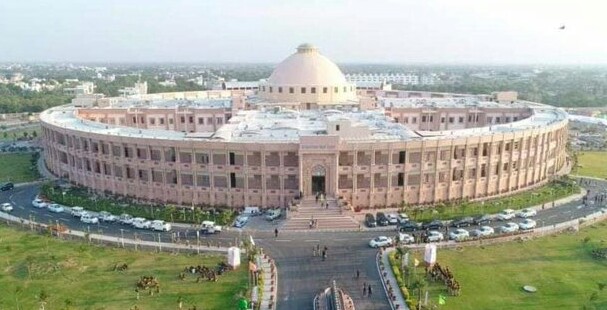The Union Budget for 2025 outlines the Union Government’s projected income and expenditures from April 1, 2025, to March 31, 2026, as mandated by Article 112 of the Constitution.
At 12:16 PM today, the Union Finance Minister proposed an estimated total receipt of INR 34.96 trillion, which falls short of the projected total expenditure of INR 50.65 trillion, leading to a fiscal deficit of INR 15.69 trillion, or 4.4% of the budgeted GDP of INR 357 trillion.
Over the past four years, fiscal deficit estimates were 6.5%, 6.4%, 5.9%, and 4.9%, indicating that the fiscal trajectory is moving in the right direction, though the pace is slow. It is crucial to reduce the fiscal deficit to 3% of GDP by next year, a target that is achievable. Raising an additional 5 to 6 trillion rupees requires commitment, not magic.
An overhaul of the revenue collection system could help generate the needed surplus, but slashing the Union Government’s massive establishment expenditure (INR 8.68 trillion) is also essential. These measures would significantly improve India’s fiscal health.
The budgeted gross tax revenue is INR 42.70 trillion, with direct taxes contributing INR 25.20 trillion and indirect taxes INR 17.50 trillion. Of the direct taxes, individuals contribute INR 14.38 trillion, while corporates contribute INR 10.82 trillion. Indirect taxes are made up of GST (INR 11.78 trillion), Union Excise Duty (INR 3.17 trillion), and Customs Duty (INR 2.40 trillion), with an additional INR 0.15 trillion from miscellaneous taxes.
The income-tax-to-corporate-tax ratio stands at 1.33:1, meaning individuals pay more in direct taxes than corporations, which is inequitable. Individuals should not be expected to subsidize corporate tax contributions. On a positive note, direct taxes are growing faster than indirect taxes, which are inflationary. Reducing indirect tax rates could help, and the loss in revenue could be recouped by imposing additional direct taxes on corporates. This is a crucial step.
The Union Government is required by Article 270 of the Constitution to share a portion of the tax revenue with the States. The budgeted transfer of INR 14.22 trillion to the States is reasonable, and the Finance Commission has done a reasonably good job over the past four years.
Non-tax revenue is budgeted at INR 5.84 trillion, which seems optimistic given the figures for the last four years, which ranged from INR 2.43 trillion to INR 5.45 trillion.
Total budgeted expenditure is INR 50.65 trillion. Given the severe fiscal strain on the Union Government, the increasing expenditure is concerning. The growing interest burden, which has risen from INR 8.09 trillion in 2021 to INR 12.76 trillion in 2025 (an increase of 58%), is particularly troubling. The interest burden alone exceeds the budgeted corporate tax revenue. If the country is to avoid an internal debt crisis, this situation needs urgent attention.
Governance is often seen by the public as spending taxpayer money without accountability, with borrowing and spending continuing even when funds are scarce. This perception is growing, and it essentially shifts the debt burden to future generations. The Fiscal Responsibility and Budget Management (FRBM) Act, 2003, was intended to promote fiscal discipline, but it has largely been ignored. It’s time to limit borrowing and enforce financial discipline.
The high establishment expenditure of the Union Government, budgeted at INR 8.68 trillion, is alarming, nearly double the defense expenditure (INR 4.92 trillion). Serious efforts should be made to reduce establishment costs. While defense spending is crucial given India’s security concerns, the government’s establishment expenditure must be reined in.
Subsidies are budgeted at INR 3.84 trillion, with food, fertilizer, and petroleum subsidies amounting to INR 2.03 trillion, INR 1.68 trillion, and INR 12,000 crores, respectively. The petroleum subsidy should be increased.
Grants from the Union Government are budgeted at INR 4.27 trillion, and pension expenditure is projected at INR 2.77 trillion, up from INR 2.43 trillion last year. While pensions cannot be reduced, some restraint is needed.
Non-development expenditure totals INR 34.17 trillion, leaving only INR 13.42 trillion for development, which is insufficient for a country with a GDP of INR 357 trillion. This highlights the urgent need for strict fiscal discipline and optimal revenue generation.
The Union Government’s total debt (both internal and external) is projected at INR 197 trillion, with a debt-to-GDP ratio of 55%. This is a concerning figure.
India’s potential is immense, but we lag behind countries like the USA and China in terms of annual budgeted expenditures. The USA spends approximately 24% of its GDP, while China spends around 4 trillion dollars annually. India’s annual expenditure, in comparison, is just about 585 billion dollars. To fund this expenditure, India must borrow at a high cost.
The revenue collection system in India has not lived up to expectations. Taxpayers still face harassment, while tax evaders are often able to collude with authorities. Corruption must be tackled, and the revenue collection system must be reformed to unlock India’s true potential.
Finally, the weakening of the rupee, which is hovering around 87 to the dollar, is detrimental to India’s economy, especially as the country’s dependence on imported crude oil increases. This continued devaluation of the rupee is not the solution to controlling inflation, boosting exports, or addressing trade imbalances.
In conclusion, India has a long road ahead. The fiscal situation must be addressed with urgency and resolve. This should be the country’s top priority moving forward.


